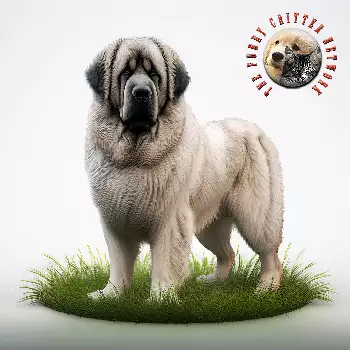American Kennel Club (AKC)
The AKC breed standard describes the Pyrenean Mastiff as a very large, powerfully built, well-balanced dog that shows strength and elegance at the same time. The general appearance should be that of a large, strong, well-proportioned dog of great beauty. The body is rectangular, being longer than tall. The head is large and strong in proportion to the body size with a moderately broad skull that is slightly longer than wide. The eyes are small relative to the size of the head, almond-shaped, preferably dark hazel, with a noble, kind, and intelligent expression. The ears are medium-sized, triangular, flat, set on at eye level, hanging naturally. The topline is straight and level. The chest is wide, deep, and powerful. The tail is thick at the base, set on at medium height, and reaches at least to the hock. The coat is dense, thick, and moderately long. The color is always white as a base, with a well-defined mask. The markings are well defined in ears and generally distributed on the head. The presence of markings on the body is common and accepted. The gait is harmonious, powerful, and elegant. The temperament is kind, noble, intelligent, and at the same time brave and fierce with strangers.
Fédération Cynologique Internationale (FCI)
The FCI standard emphasizes that the Pyrenean Mastiff is a dog of large size, hypermometric, with a strong constitution and great functional harmony. The dog should be muscular, with compact bone structure and a well-balanced profile. The head is large and strong, but not excessively heavy. The skull should be wide, strong, slightly convex in profile. The eyes are small in relation to the skull, almond-shaped, preferably dark hazel colored, with an alert, noble, sympathetic, and intelligent look. The chest is wide, deep, muscular and powerful. The ribs are well sprung. The abdomen is moderately tucked up. The coat is dense, thick, of moderate length, and smooth to the touch, longer on shoulders, neck, belly, back of legs, and tail. The ground color is white, always with well-defined mask. Ears should always be colored. Markings well distributed over the head are highly valued. Presence of patches on the body is also admitted and valued. Tricolor animals are especially valued. The movement should be the typical movement of a molossoid: preferably a slow trot, powerful, balanced and elegant, without any tendency to amble. During the trot, the feet should move in straight, parallel planes. The character should be affectionate, calm, noble, and intelligent, showing determination when acting as a flock guardian or defending his territory, family or property.
United Kennel Club (UKC)
The UKC breed standard describes the Pyrenean Mastiff as a giant breed dog that was developed in the Aragonese Pyrenees as a livestock guardian. The breed should be powerful, well-muscled, and well-balanced. Size is important but must be in proportion with the overall balance and functionality. The head should be large and strong, in proportion to the body, conveying power and nobility. The skull is broad and slightly rounded. The eyes are relatively small for the head size, almond-shaped, and dark amber to dark brown in color. The expression should be alert, noble, and intelligent. The ears are medium-sized, triangular, and thick, set at eye level. The body is longer than tall, powerful and well-muscled throughout. The coat is moderately long, thick, and straight or slightly wavy, with a dense undercoat. The base color is white with clearly defined colored markings. The gait should be balanced and powerful, covering ground efficiently. The temperament should be calm, confident, and noble, with strong protective instincts but stable character that allows for appropriate discrimination between normal situations and genuine threats.
Other Organizations
The Real Sociedad Canina de España (RSCE), as the breed's country of origin organization, maintains detailed standards that emphasize the breed's working heritage and functional conformation. The Club del Mastín del Pirineo works closely with international organizations to preserve breed type and character. The Canadian Kennel Club follows standards similar to the FCI, while the Australian National Kennel Council recognizes the breed under FCI guidelines. Most European kennel clubs emphasize the breed's role as a livestock guardian and the importance of maintaining working ability alongside physical conformation. Disqualifications typically include aggressive temperament, lack of breed type, improper coat color patterns, and structural defects that would impair working ability. All standards stress the importance of balanced temperament that combines guardian instincts with stable, controllable behavior suitable for family life.

